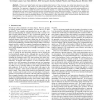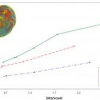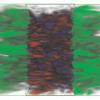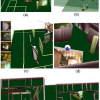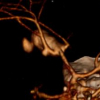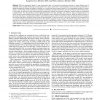VIS
2007
IEEE
15 years 25 days ago
2007
IEEE
Proteins are highly flexible and large amplitude deformations of their structure, also called slow dynamics, are often decisive to their function. We present a two-level rendering ...
VIS
2007
IEEE
15 years 25 days ago
2007
IEEE
r Surface Abstraction Gregory Cipriano, Student Member, IEEE, and Michael Gleicher Abstract-paper we introduce a visualization technique that provides an abstracted view of the sha...
VIS
2007
IEEE
15 years 25 days ago
2007
IEEE
Hardware-accelerated volume rendering using the GPU is now the standard approach for real-time volume rendering, although limited graphics memory can present a problem when renderi...
VIS
2007
IEEE
15 years 25 days ago
2007
IEEE
We present a powerful framework for 3D-texture-based rendering of multiple arbitrarily intersecting volumetric datasets. Each volume is represented by a multi-resolution octree-bas...
VIS
2007
IEEE
15 years 25 days ago
2007
IEEE
We describe a novel volumetric global illumination framework based on the Face-Centered Cubic (FCC) lattice. An FCC lattice has important advantages over a Cartesian lattice. It ha...
VIS
2007
IEEE
2007
IEEE
Contextualized Videos: Combining Videos with Environment Models to Support Situational Understanding
15 years 25 days ago
Multiple spatially-related videos are increasingly used in security, communication, and other applications. Since it can be difficult to understand the spatial relationships betwee...
VIS
2007
IEEE
15 years 25 days ago
2007
IEEE
VIS
2007
IEEE
15 years 25 days ago
2007
IEEE
New product development involves people with different backgrounds. Designers, engineers, and consumers all have different design criteria, and these criteria interact. Early conce...
VIS
2007
IEEE
15 years 25 days ago
2007
IEEE
Although real-time interactive volume rendering is available even for very large data sets, this visualization method is used quite rarely in the clinical practice. We suspect this...
VIS
2007
IEEE
15 years 25 days ago
2007
IEEE
With the exponential growth in size of geometric data, it is becoming increasingly important to make effective use of multilevel caches, limited disk storage, and bandwidth. As a r...
